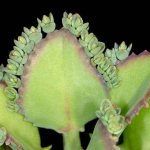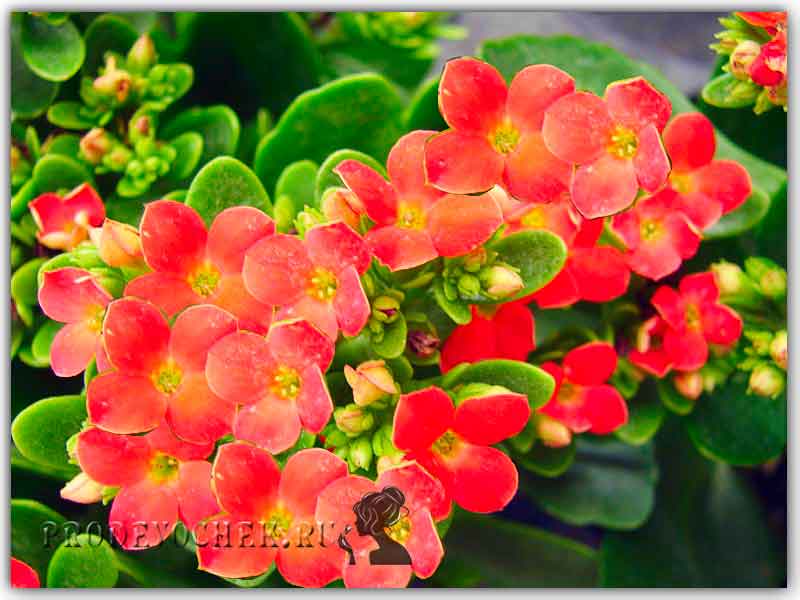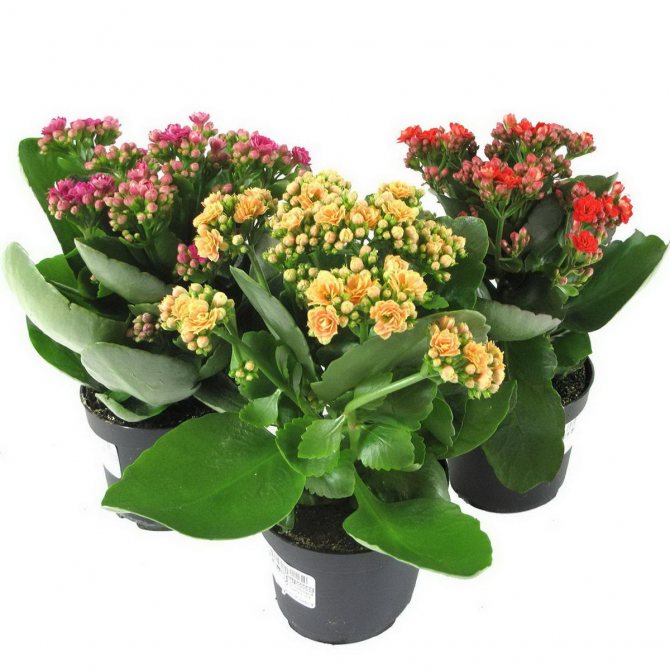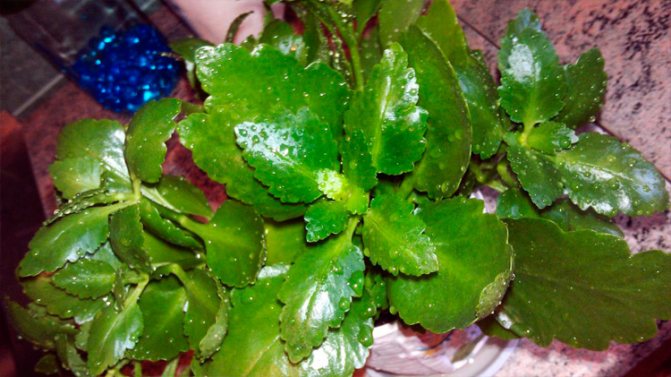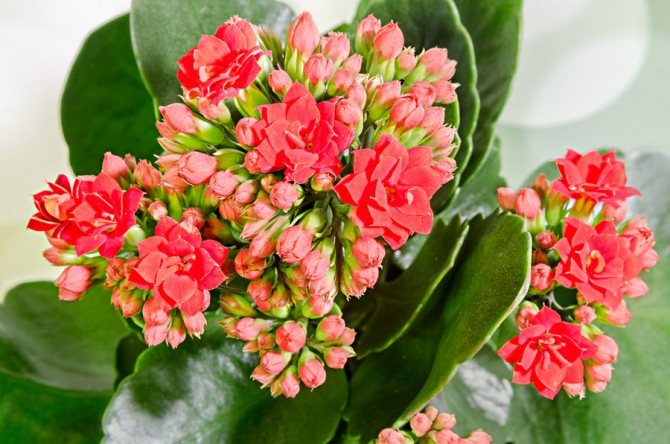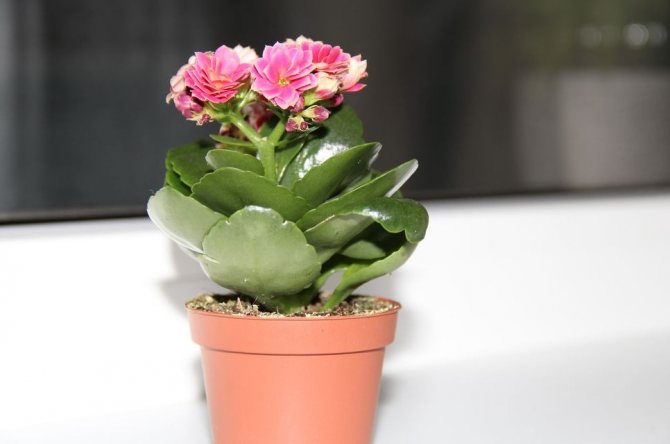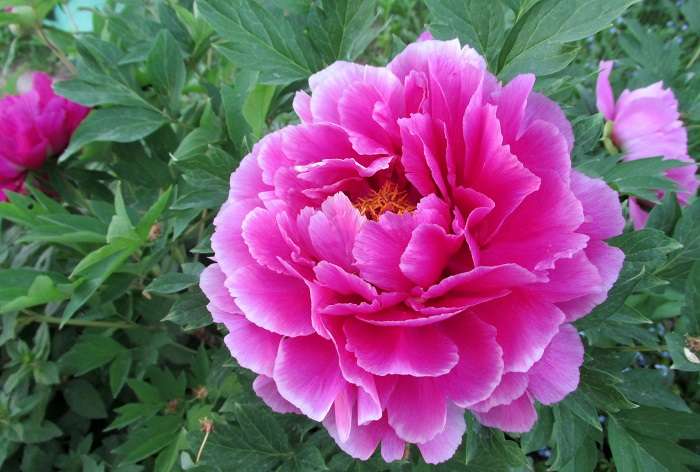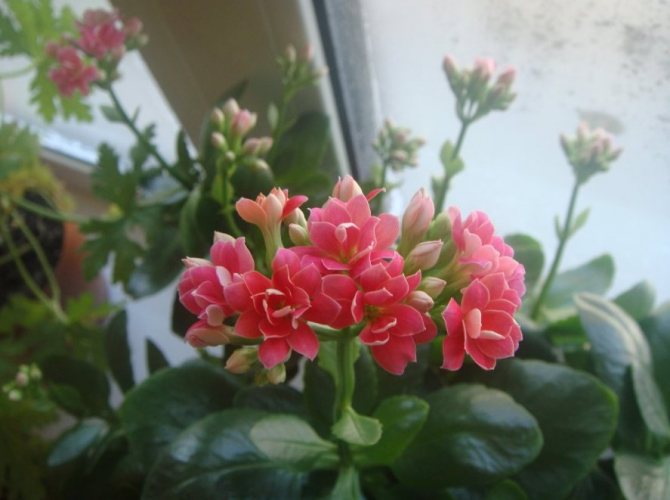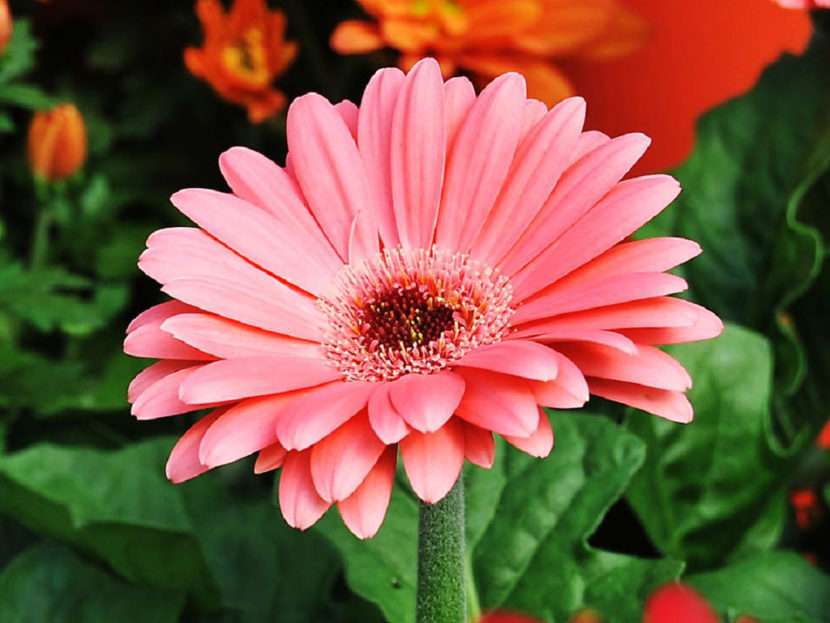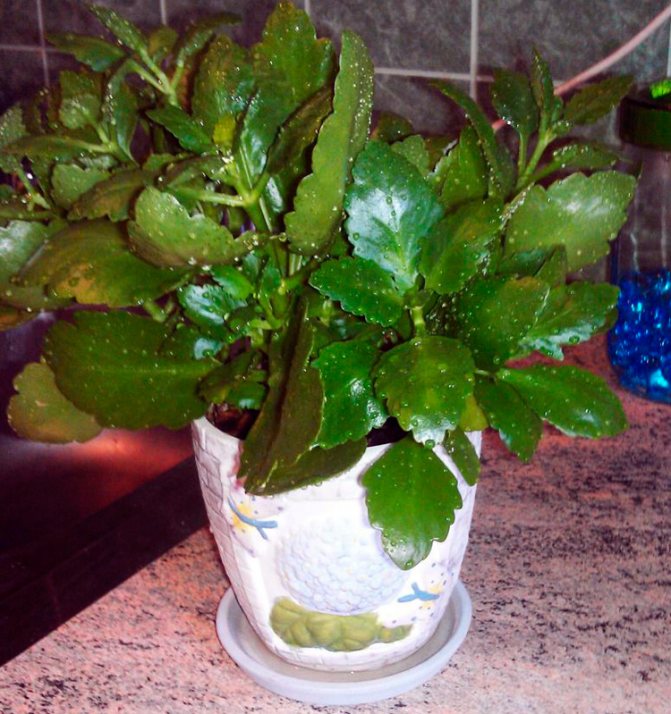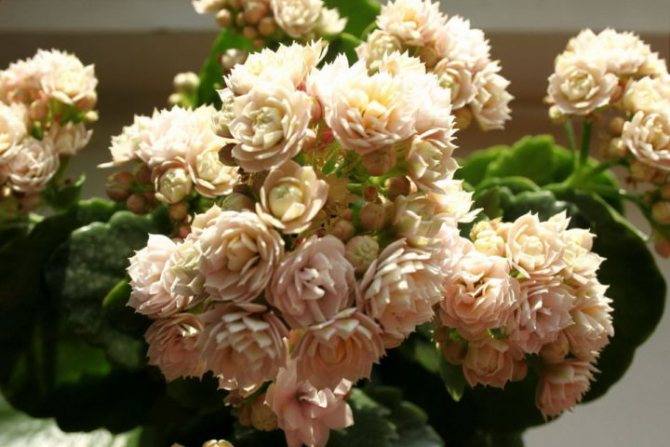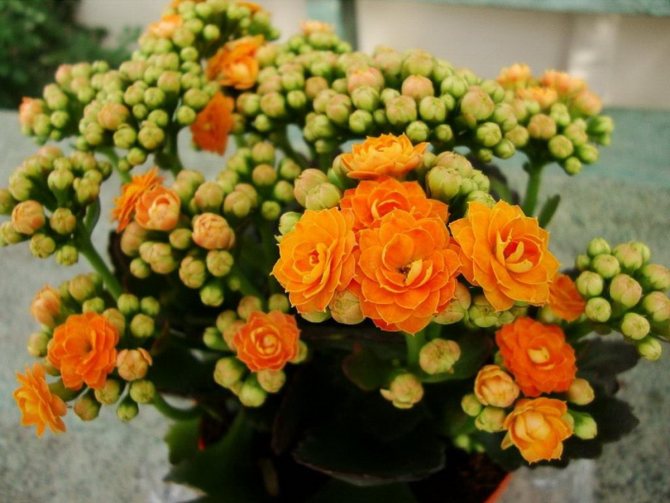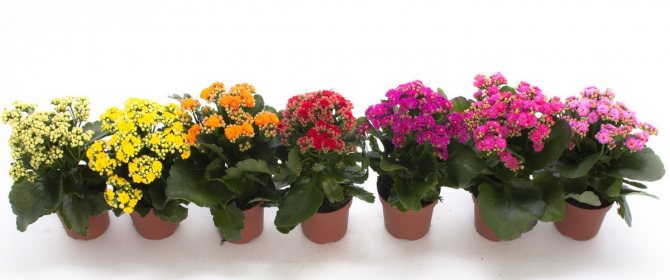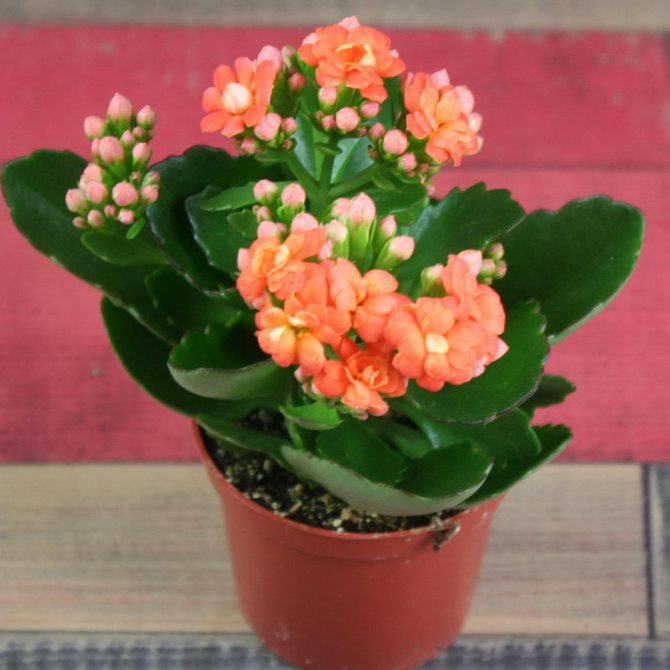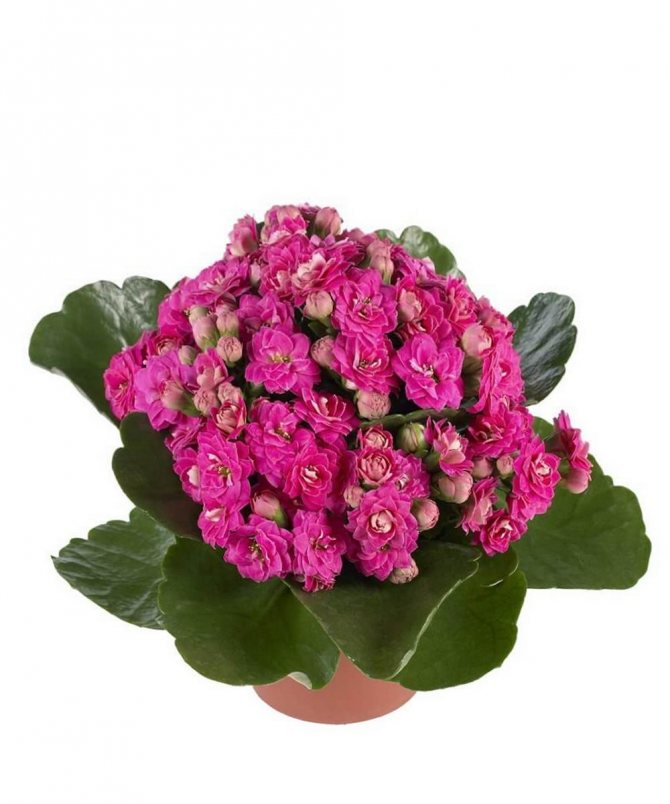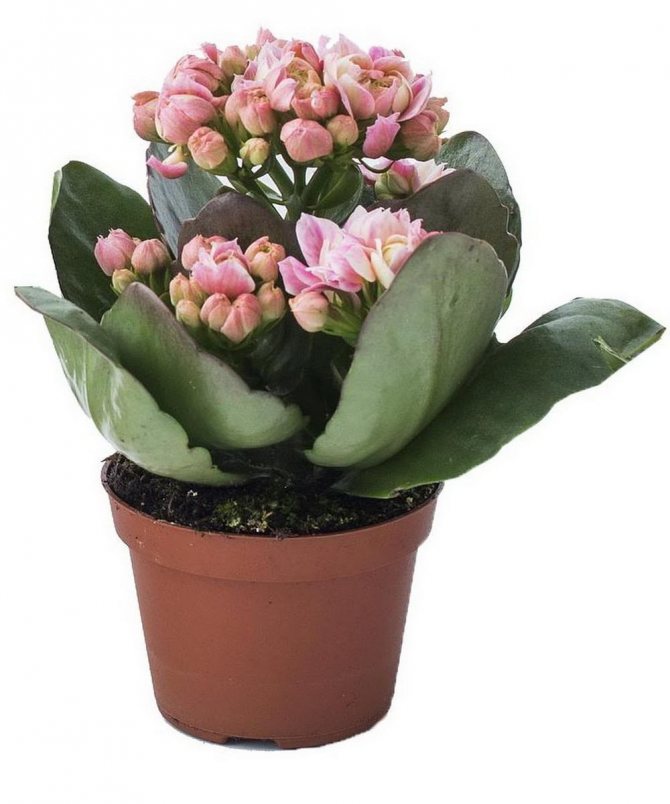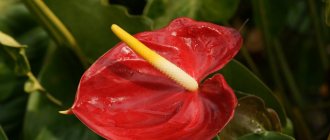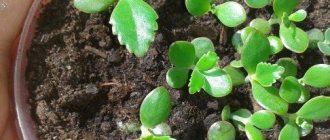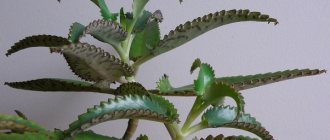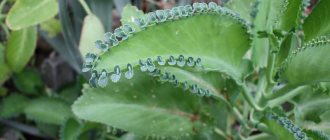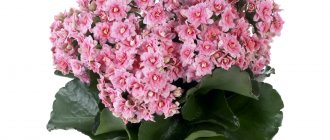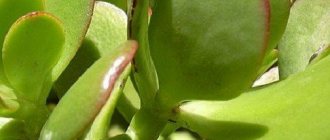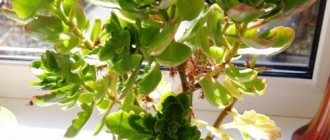The amazing flowering succulent Kalanchoe reproduces in several ways. Florists need to know how to propagate Kalanchoe at home in accordance with the variety. So, for example, most often Dergomon, pinnate and tube-flowered Kalanchoe, are propagated by species buds. But the varieties with fleshy leafy plates, cuttings and leaves, Blossfeld and Mangin are offspring. Panicle-flowered ones reproduce by axillary buds, and over-grown and tomentose buds - by seeds.
But this does not mean at all that a different technique cannot be used for a particular variety.
Care for the houseplant Kalanchoe Blossfeld. How to care for Blossfeld's Kalanchoe?
Kalanchoe is a dream for flower lovers who cannot devote much time to caring for a houseplant, at the same time, an unpretentious culture that requires a minimum of attention. Nevertheless, the appearance and flowering directly depends on how we care for the Kalanchoe and what conditions we provide.
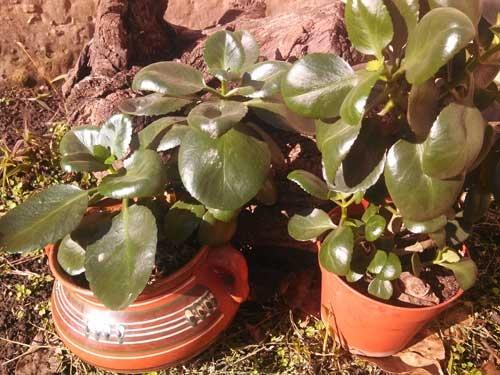
- Temperature and lighting.
The most optimal and comfortable temperature is from + 18 * C to + 20 * C. In summer it can be higher, and in winter not lower than + 10 * C. Fluctuations in temperature indicators are not dangerous for the plant.
In order for the flowers of the Kalanchoe to be as brightly colored as possible, the plant must receive a lot of light during the growth period. In winter, we keep a flowerpot with a flowering plant on the southern, southeastern side. So that the leaves do not lose their decorativeness, the Kalanchoe from spring must be rearranged to a not too hot, but sufficiently illuminated place or shaded.
The leaves turn brown in the direct midday sun. On the north side, it will lack lighting, which can negatively affect its flowering and development.
- Watering and humidity.
No additional moisture is required for normal growth. It is desirable that heating devices and gas stoves be as far from the plant as possible.
As a succulent plant, Kalanchoe contains a large amount of cell sap in the leaves and shoots, which makes it possible to easily survive a prolonged lack of moisture. In the summer we water as the soil dries out, abundantly, and in the winter it will be enough once a week. Spraying is not necessary.
Excessive moisture is detrimental to Kalanchoe, the roots rot and the plant is exposed to fungal and bacterial diseases. The flower tolerates drought much easier.
- Transplant and soil.
The plant does not need special soil and is not sensitive to acidity indicators. Ordinary turf soil mixed with peat and sand will be an excellent basis for growing Kalanchoe.
They are usually transplanted after flowering, but if there is an urgent need, then it can be transplanted by the transshipment method - without destroying the clod of earth.
- Top dressing.
Fertilized once a month from April to September with flower fertilizer. At the beginning of autumn, fertilizing is reduced, and by winter they are completely stopped. While the green mass is growing, you can feed a little with fertilizer for decorative deciduous species.
How is the flowering period in Kalanchoe
Kalanchoe is a succulent plant that blooms in late winter - early spring. There are many varieties of Kalanchoe Blossfeld (height 30–45 cm) and Kalandiva (height 15–20 cm) with flowers of various colors and shapes, which are always collected in dense inflorescences.
The flowering period can range from several weeks to two months, depending on varietal characteristics and growing conditions. It can be moved using artificial light limiting.
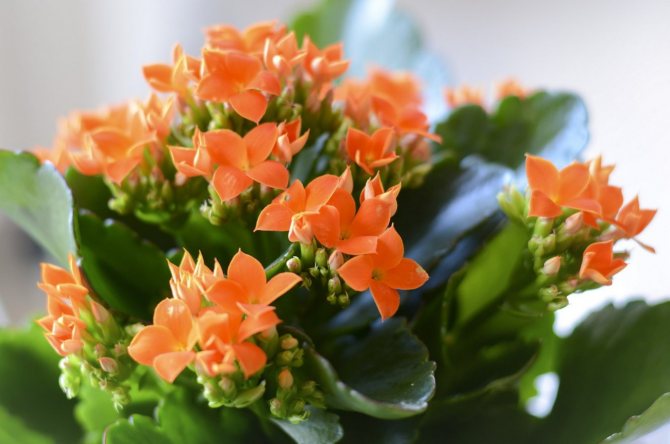

Kalanchoe Blossfeld has medicinal properties. Kalanchoe with sinusitis
The healing properties of Kalanchoe Blossfeld are fully manifested in the treatment of such a serious disease as sinusitis. So that a mild cold does not result in serious consequences, it is necessary to correctly combine the drugs prescribed by the attending physician and traditional medicine, for example, Kalanchoe juice.
In the treatment of sinusitis, this plant has healing properties such as:
- Stimulation of the secretion of the secretion of the sinuses of the nose (that is, the very cleansing of mucus, which was mentioned above);
- Disinfecting and healing effect;
- It is not toxic and has no other contraindications, except for individual intolerance.
Kalanchoe can be used in several variations: as part of a medication sold without a prescription in any pharmacy, as an ointment, juice or tincture.
The drops sold at the pharmacy are good and easy to use, however, their price is quite high.
Therefore, if you have the opportunity to prepare a remedy for combating sinusitis at home, use several recipes below.
- Cotton swabs with Kalanchoe-based ointment are injected into the nose for 1-2 minutes, several times a day. 30 ml of Kalanchoe juice is mixed with 50 g of lanolin and 50 g of petroleum jelly.
- An infusion based on plant juice is prepared as follows: chop the cut plant to a mushy state, squeeze this mass through cheesecloth and leave to settle for two to three days in a dark and cool place. After that, dilute the juice with alcohol in a ratio of 20: 1 and apply the tincture several times a day, 1-2 drops in the nose.
- Another equally effective recipe is to mix Kalanchoe, aloe and onion juices in equal proportions.
- Decoctions from the leaves of the "tree of life" work well for small children, as the effect becomes a little softer. 2-3 leaves of the plant are finely crumbled, poured into a thermos with half a glass of boiling water and infused for an hour. This infusion should be instilled three times a day, two drops in each nostril.
Kalanchoe in the treatment of sinusitis not only helps to get rid of the disease itself, but also prevents the development of complications. However, it is worth remembering that treatment will only be successful when traditional medicine is used in combination with drugs prescribed by a doctor.
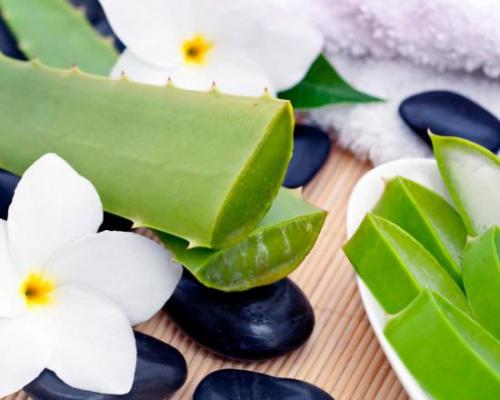

Typical diseases
Kalanchoe Blossfeld is a variety that is highly resistant to diseases and pests. However, he still has several enemies. Excess nitrogen in the soil and high air humidity can cause powdery mildew. The main symptom of this ailment is a gray-white coating on the leaves. For the treatment of fungal diseases, fungicidal preparations are used.
In conditions of high humidity, the flower can also infect stem rot. Its appearance is evidenced by black watery spots on the branches and leaves. To combat the disease, insecticides are used. If they do not help, the diseased plant must be destroyed so that the disease does not spread to the flowers growing in the neighborhood.
Multi-claw mites can attack the plant. If they settle on Kalanchoe, a brown scab forms on the leaves and petioles. Flower tissues gradually bend and harden. The growth of the leaves stops, their edges begin to bend. If you look closely at the plant, you will notice that tiny white glassy mites have settled on it.
Excessive dryness is no less harmful for a pet. In this case, the risk that the flower is attacked by mealybugs increases. You need to remove them manually. To avoid the reappearance of pests, it is necessary to increase the humidity of the air and treat the plant with insecticides.
Kalanchoe Blossfeld is resistant to various diseases and parasites. But, they can appear if you do not follow the rules of caring for a perennial succulent.The parasitic fungus infects bushes with excess moisture, for the same reason, various harmful bacteria and other microorganisms arise. When kept outdoors, especially in summer, Kalanchoe can infect aphids, it eats up the lower leaves. To get rid of it, the plant is treated with soapy water, avoiding it getting on the buds.
Kalanchoe Blossfeld value. How to make Blossfeld's Kalanchoe bloom?
Most often, a flowering plant with a small rosette of leaves, a lush mass of flowers and a small supply of nutrients in a transport pot enters the house. While the Kalanchoe is blooming, you should not transplant or feed it. It is much more correct to choose a suitable planter for the bush, which can reduce excessive evaporation of moisture and make the plant acclimatize faster.
When Blossfeld's Kalanchoe begins to fade, the wilted peduncles are removed, which will redirect the forces of the bush to the remaining buds. Bearing in mind the unpretentiousness of the plant and the uselessness of special care for Blossfeld's Kalanchoe at home, many novice gardeners, after the last flowers wither, transplant the bush into a permanent pot and put it on the windowsill, waiting for the imminent flowering. And here they are often disappointed.
To see bright buds again, it is important to know and take into account the peculiarities of cultural life, as well as skillfully make Blossfeld's Kalanchoe bloom.
This culture has both pronounced periods of growth and seasons of dormancy. This is the time that comes after all the flowers have wilted. The plant must restore strength, give an increase in green mass and lay new flower buds.
In nature, Kalanchoe bloom in autumn, when daylight hours naturally diminish in the middle lane.
To lay future buds, the plant needs to be in the light no more than 10 hours a day, if the lighting is longer, then the plant perceives this as a signal for growth, starting to give new shoots and foliage, "forgetting" about flowering. Therefore, after the withering of the inflorescences, the Blossfeld Kalanchoe is transplanted, fed and necessarily cut off in order to cause the appearance of new lateral shoots.
And then the plant is transferred to a short day mode, putting the pot on the window in the morning, and after 10 hours removing it in a dark place or covering it with an opaque cap. In this case, in the middle of autumn or by winter, the plant will bloom. What are the requirements of Blossfeld's Kalanchoe for care, transplantation and reproduction?
Pests, diseases and treatments
The Kalanchoe Blossfeld flower, home care for which is simple and straightforward, in some cases is exposed to diseases and pests. The causes of damage can be different, but in order to prevent or deal with them, you should be aware of the possible threats.
If, during a visual inspection, a grayish bloom of an unpleasant consistency, consisting of small insects, was found on the surface of the plant, we can safely say that the Kalanchoe is affected by scabies. As a result of their activity, the general condition of the flower is rapidly deteriorating, fungal lesions appear, and flowering stops.
Scabbards secrete toxic acidic mucus, so that their removal must be preceded by alcohol treatment of plant surfaces. The insects can then be removed with a soft cloth or brush, completing the cleaning with a second alcohol treatment.
With a significant lesion with a scabbard, you can use not pure alcohol, but a specialized flower medicine based on it, which is offered in stores. After processing, Blossfeld's Kalanchoe completely recovers on its own.
The most common and dangerous damage to a plant of this species.It can be detected quite simply: on the stem and leaves, small greenish insects are almost always observed, affecting any life processes of the plant due to the complete cessation of access of nutrients to the root system of the flower. Therefore, it is no wonder that Kalanchoe can easily die from the activity of such pests. Do not delay the start of the fight against aphids.
If the leaves of Kalanchoe Blossfeld begin to dry out, turn yellow and lose their shape, and the inflorescences fall off or do not appear at all, there is no doubt that the defeat of aphids is already very serious. First of all, the affected areas should be immediately removed, and the rest of the flower should be copiously treated with potassium soap and / or alcohol solution.
It is noteworthy and extremely important that the plant does not tolerate the ingress of these substances into the soil, which is why it must be covered before processing.
The most frequent cases of the disease of this plant and the attacks of pests are directly related to a violation in the care and conditions of detention. In order to further protect the Kalanchoe from risks, it is necessary to follow the recommendations of specialists.
In conclusion, we can summarize that Blossfeld's Kalanchoe is great for home cultivation. Due to its ease of care and amazing unpretentiousness, the plant has been very popular in our country for many years and every year it becomes a favorite in new homes.
Pests rarely affect the plant. Sometimes it can suffer from aphids, which get rid of by wiping the foliage with soapy water.
Flower diseases are also not common. When waterlogged, rot and mold can develop. It is necessary to cut off the diseased parts of the plant and treat it with any fungicidal agent permitted for enclosed spaces.
What to do if Kalanchoe Blossfeld's leaves turn yellow or does not bloom? This is due to improper care. The main reason is irregular and excessive watering.
Also, the tips may turn yellow due to too hot and dry air.
In winter, yellowing occurs with a significant drop in temperature and insufficient lighting.
Observing simple care rules, you can achieve a long plant life and lush flowering. And it will be a beautiful annual gift for us for the winter holidays.
Improper care of Kalanchoe can lead to diseases. The plant suffers from excessive soil moisture, lack of lighting, temperature changes in the room or drafts.
A weakened bush is more often affected by harmful insects that spoil its appearance and even lead to death, if you do not start a fight with them in time.
If the leaves of the plant become pale, then it does not have enough light. The lack of flowering may be due to insufficient water or not during the feeding.
Red spots on the leaves indicate that the plant is attacked by mites of different claws. The appearance of white tubers indicates a mealybug; it rarely can be attacked by aphids. The method of fighting parasites is quite simple: the leaves must be wiped with a cotton swab soaked in an alcohol solution.
Kalanchoe Blossfeld benefit. Kalanchoe Blossfeld
Caring for Kalanchoe Blossfeld at home
The article devoted to the intricacies of growing this not only beautiful, but also useful plant will begin with how to care for the Kalanchoe Blossfeld at home. In general, it does not bring any inconvenience, it is not burdensome and consists only in the correct humidity of the air and the choice of a place that would be sufficiently well protected from direct sunlight, but would be sufficiently illuminated. In order to understand that there is enough light for the plant and in this place the Kalanchoe feels comfortable, it is worth focusing on the color of its leaves, they should have a red tint around the edges.
In the summer, the Kalanchoe needs to be watered well, but only after the soil has completely dried out, he does not really like filling with water. As for the cold season, watering is extremely rare - 2-3 times a month. The fleshy leaves of Kalanchoe are able to retain moisture for a long time in order to survive in their natural environment. With the Kalanchoe, the rule is that it is better not to top up than to pour, and if, nevertheless, it becomes a lot of water, then the plant shows this by the appearance of brown spots on the leaves. Recovery of such leaves is not typical, so they need to be cut off and a fungicide applied to the cut. (And by the way, the fungicide can be purchased, including online, since all garden stores are acquiring that allow making calculations directly on the Internet).
Another plus in the care of clanchoe is the absence of the need for spraying, it feels good enough in dry air. Top dressing is applied in the summer and is by no means organic.
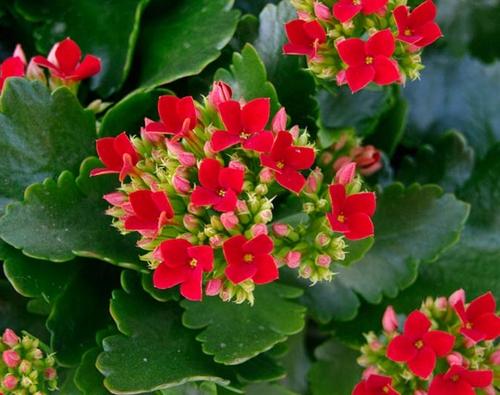

The healing properties of Kalanchoe Blossfeld
As for the kalanchoe, they are very famous, justify themselves and are widely used even with the development of the pharmaceutical industry at such an incredible pace as it is now. Probably everyone remembers how Kalanchoe's nose was buried in his childhood and this is just one of the applications. Kalanchoe itself acts as an antiseptic, has the ability to purify the air in the room, to disinfect it.
In general, Kalanchoe is a natural remedy for disinfecting, relieving inflammation, cleansing the body and blood from harmful substances and toxins. With its help, you can heal wounds, improve the condition of the skin with skin rashes. In addition, Kalanchoe has the ability to stop blood. That is why it is worth having at least one such plant in your home. And supporters of traditional medicine and energy practices argue that Kalanchoe cheers up, contributes to the formation of a positive atmosphere in the room.


Reproduction of Kalanchoe Blossfeld
In order for the Kalanchoe to grow into a good spacious bush, you need to cut off its tops every year. They can be used as seedlings and thus a plant. Rooting can be carried out in water or directly in the ground, it is so, and so it goes well. It is also advisable to cut the lateral stems periodically and use them for the same purpose. Pruning Kalanchoe Blossfeld is a very useful action.
Separation at, which is carried out once every two years, is not practiced, since the root system of the plant is small and is not able to grow and develop quickly. Yes, and there is no such need, there are much simpler options - the Kalanchoe takes care of its reproduction on its own, pouring the children just from the tips of their leaves. Therefore, before transplanting the Blossfeld Kalanchoe, you should not plan to immediately increase the number of copies, this is not the best option.


Diseases of the Kalanchoe Blossfeld
Almost most of the Kalanchoe Blossfeld diseases arise from improper care, for example, a violation of the irrigation system or an excess of light. However, there may be problems caused by pests and parasites. Most often it is aphid and this is the worst thing that can happen to a green doctor. It weakens the Kalanchoe and poisons it with its poison. Aphids are dangerous in that they are extremely difficult to detect; they become noticeable even when a large number of them multiply and the plant is already exhausted by that time. The leaves turn yellow, fall off, the buds do not have the strength to bloom and do the same thing as the leaves, the bush itself is deformed, the leaves become dirty.
Infected leaves must be removed immediately, and the plant itself must be treated with an insecticide every week.It is imperative to arrange a quarantine for the plant, separate it from others, so as not to provoke an epidemic and not get rid of the entire home garden.
Another dangerous insect is scale insects and it is easier to see them with the appearance of plaque on the leaves. The insects themselves, reaching up to 2 millimeters in length, are quite noticeable. The scale insects weaken the plant, it stops blooming, the leaves turn yellow and fall off. In addition, the scabbard provokes the appearance of a fungus, so it must be eliminated as soon as possible. To do this, you can wipe the leaves with an alcohol solution, then soapy, collecting insects. Infusion of 5-6 cloves of garlic also works well, unless, of course, the smell is taken into account.
There is also late blight rot, which is characterized by the appearance of spots of a putrid color, powdery mildew, which is characterized by the presence of a gray plaque on the leaves, gray rot, the name of which speaks for itself and all of them can be eliminated by applying fungicides in time.
Reproduction
Reproduction of Kalanchoe occurs in several ways. Each gardener chooses the method that seems most convenient.
- 1 When a bush is propagated by leaf cuttings, fallen leaves are used. It is necessary to choose only those that have recently separated from the stem, look strong and healthy. The sheet is placed in a small container of wet sand. From above, the container is covered with a plastic bag or glass jar, and then left in a dark room. Care must be taken to keep the sand moist at all times. After a while, the first roots will grow.
- 2Kalanchoe can be propagated by children only if excretory buds have appeared. They are carefully separated from the mother plant and planted in the same way as described above.
- 3 Propagation by stem cuttings can be carried out in the spring or summer. You need to carefully cut off the top part of the stem and place it in a container of water. When the first roots appear, the young seedling is ready to move to a separate pot.
- 4Cultivation of Kalanchoe from seeds is the longest and most labor-intensive method. Usually it is not used by amateurs, but by experienced florists. Seeds are planted in soil, the main component of which is leaf humus. From above, the container is covered with a jar and placed in a dark place. Several times a day, the impromptu greenhouse must be removed so that the soil is ventilated. You also need to ensure that the ground is constantly wet. Otherwise, the seeds will dry out and will not sprout. When the first shoots appear, the jar is removed, and the containers are placed in the light. After about a month, leaves are formed, they need to be dived into separate pots.
It is recommended to plant young seedlings in a substrate that includes 4 parts of sod land, 2 parts of leafy soil, 1 part each of sand and humus. In such a nutrient soil, they will take root as quickly as possible. To form a bush, the tops of young plants need to be pinched. At the end of the summer season, when the roots are tightly entwined with an earthen ball, transshipment should be made. If you follow all these recommendations, in a year the Kalanchoe will delight the owner with lush flowering.
Reproduction of Kalanchoe Blossfeld is carried out easily by cuttings: stem or leaf. The cut stem cutting is dried for a couple of days in a shady place, and then placed in a substrate based on sand or perlite and peat soil (equally).
Placed in a warm place (22-25 degrees), the cuttings take root in two weeks. The leaf cuttings planted in the ground are covered with a transparent cap, so “kids” are formed on it faster. Seed propagation is usually used for breeding purposes.
The plant propagates by seeds and stem or leaf cuttings. Rooting of cut cuttings is best during the warmer months. Seeds are sown in spring in a container with a light substrate. Cover it with glass and put it in a warm, bright place.When sprouts appear, the glass is removed.
Cuttings for propagation are cut with two or three pairs of leaves, and the lower ones are cut off so that they do not interfere. Kalanchoe grows roots in water, but it is better to root it in the substrate. Freshly cut cuttings are dried in the air for several hours or the cuts are treated with wood ash from a burnt match. The rooting substrate is chosen the same as for planting - light and nutritious for succulents. You can mix it with sand or vermiculite.
- For rooting, take small plastic containers with holes in the bottom.
- Drainage is poured onto the very bottom, filled with soil and cuttings are planted.
- The earth is slightly moistened with a spray bottle, the Kalanchoe is placed in a bright, warm place.
- In the first week, you can cover the seedlings with a transparent plastic bag for better rooting.
Like other species and varieties of Kalanchoe, this plant is not difficult to propagate using cuttings or leaves. You can cut the planting material when the perennial is at rest. During the flowering period, Kalanchoe Blossfeld gives all its strength to maintain budding. In summer, rooting of cuttings occurs twice as fast as in winter, when this process can take up to 1.5-2 months.
For reproduction, fresh young shoots are taken, not injured and without traces of the vital activity of parasites. Cuttings 7-8 cm long are suitable. It is important that several pairs of leaves are present on the planting material. The lower leaf plates are removed, leaving only the upper ones, they are younger and promote rooting well. Usually, flower growers leave no more than two pairs of leaves on the cuttings.
For rooting, you can use one of the following formulations:
- water with the addition of a few drops of perlite or root;
- humus in equal proportion with peat and clean sand;
- wet clean sand.
You can immerse the stalk into the composition by no more than 3 cm.Further, the plant will need to be kept in a warm room with diffused light. Direct sunlight promotes rapid evaporation of moisture and burns young seedlings. Some growers for rooting cuttings cover them with a transparent cap (jar or tighten the container with a film). After the roots have formed, the plant can be transplanted into a ceramic pot.
To propagate Blossfeld's Kalanchoe with leaves, take healthy plant organs and dry them at room temperature for 12 hours. After this procedure, we lay out the sheet plates on a damp substrate. The container with landings is tightened with a transparent cap to maintain optimal temperature and humidity.
The Kalanchoe has all possible methods of reproduction, however, preference is given to vegetative reproduction.
Propagation by cuttings involves the use of either a large leaf or a stem with 2-3 leaves as a cutting. The stalk can be rooted immediately into almost any soil to a depth of about 2 cm by tilting it at a slight angle. Sometimes ordinary sand is recommended as a soil, since the root system in it will develop faster.
In the case of using sand, the rooting depth should not exceed 1 cm. Regardless of the soil used, immediately after rooting, the cutting is watered with warm water and covered with a glass or plastic bottle for several days. This approach allows you to create conditions for a young shoot, close to those of a greenhouse; rooting in them is faster.
Sometimes it is recommended to dry it at room temperature before settling the stem cuttings for 24 hours. In this case, after rooting, it is necessary not to cover the stalk, but to wrap the entire pot with the stalk with plastic wrap, after watering it. Reproduction by cuttings is best done in late May - early June.
In Kalanchoe pinnate and Degremon, many children are formed that can be used for reproduction. Their advantage is that they already have a root system and they can be grown without any problems at all.
As a rule, children removed from the mother plant are poured into a hotel "seedling" container and covered with a layer of soil about 1 cm thick. The planting must be watered daily with warm water. Within a week, 1-2 cuttings grow from each baby, which after a month are transplanted into individual pots.
Kalanchoe Blossfeld leaving. Plant care
Kalanchoe Blossfeld does not require any special care at home. The soil requirements of this flower, like other succulents, are small.
The soil must be selected light, consisting of sand or perlite, peat or humus and sod land, which are taken in equal shares. At the bottom of the flowerpot, you need to put good drainage.


Top dressing is carried out all year round and is combined with watering. They are brought in once every 2 weeks in the summer and every 3-4 weeks in the winter.
If the Kalanchoe develops and blooms normally, it is enough to limit yourself to a standard fertilizer for succulents containing trace elements.
Weak formation of flower buds signals a lack of phosphorus salts, insufficient development of the leaf apparatus - a deficiency of nitrogen nutrition.
Air humidity does not greatly affect the flower, although excessive dampness harms it.
With a moisture content of more than 80%, spotting appears on the leaves and buds, they can die off. Kalanchoe tolerates dry air well. Light spraying is needed for the plant only occasionally.
The optimum temperature for keeping Kalanchoe Blossfeld is 17-20 ℃ in the cold season and about 25 ℃ in summer. Too hot days with temperatures of about 30 ℃ will be unfavorable: the plant will tolerate them without visible harm, but it will lose a lot of strength.
Cold snaps are not so critical, but temperatures below 4-6 ℃ should be avoided: a native of Madagascar may not survive such conditions.
The light regime is most important for the Kalanchoe. Of course, the flower will grow at any level of illumination and length of the day, but flowering is tied precisely to these conditions.
In winter, during the period of active flowering, the plant needs bright light.
The ideal position is a south window. In summer, less light is needed and the Kalanchoe is rearranged to the western or eastern window. The duration of the lighting is also important. The signal for bud formation is a short day.
Preparation for flowering in Kalanchoe begins after the length of the day becomes less than 12 hours. To stimulate flowering, you need to shorten the duration of the lighting.
To do this, from September, the flower is covered with an opaque cap, creating a daylight hours for it with a duration of 9-10 hours. In such conditions, it will bloom just in time for Christmas and New Year, which makes it a wonderful gift for the holidays.
Pruning is done after the plant has faded.
The peduncle is cut as low as possible, to the first large leaves. As a result, conditions will be created for the establishment of new flowering shoots. Old elongated specimens also need pruning. Their tops are cut off, which can then be rooted.
Harbingers of problems
Kalanchoe always shows with its appearance if something is wrong with it:
- Fading and lightening of the color of the leaf plates - in a room with an indoor flower, an excessively high air temperature is maintained.
- Lighter and dried out areas appeared on the foliage - a sunburn.
- Shredding of leaf plates and the rapid growth of shoots - a lack of sunlight.
- Deceleration of foliage development and peduncle growth - excess lighting and heat.
- Foliage withering - overflow and stagnation of fluid. Sometimes a plant transplant is required with the removal of decayed areas of the root system.
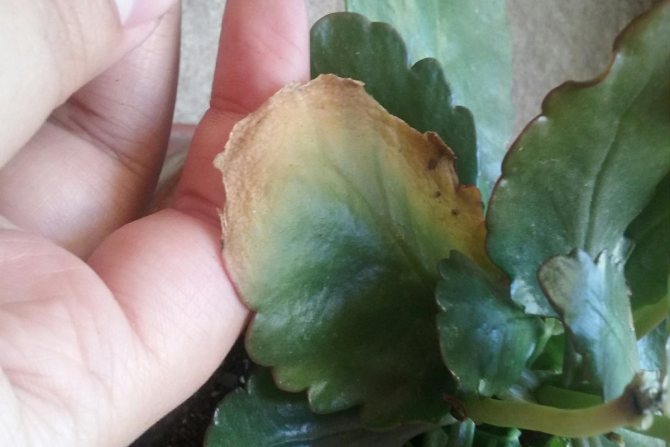

Kalanchoe. Botanical characteristic
Kalanchoe is a genus of perennials of the fatty family, which unites more than 200 varieties. In nature, these plants grow in Australia, Africa, Central America. Most of them are grown as ornamental crops. But some species have great healing power.
Common types
Studying the medicinal properties of the Kalanchoe, scientists have identified several of the most valuable from a medical point of view. These plants easily take root on the windowsill in the apartment. They do not require specific maintenance. Large thick leaves are used as raw materials for medicinal and cosmetic purposes. The plant has three types.
- Kalanchoe is pinnate. It is this plant species that has undergone careful study. It is used in mainstream medicine for the manufacture of pharmaceuticals. Most often, when they say "medicinal Kalanchoe", they mean the feathery look. The plant can reach a height of 2 m. It has a fleshy tree-like stem with round glossy leaves. Leaf buds are formed on the teeth, providing the plant with vegetative propagation. Flowering is observed in the cold season. Large axillary panicles appear on the pedicels.
- Degremona. Another very common type of indoor Kalanchoe. Its peculiarity is the formation of children at the edges of the sheets. Such babies are very easily separated from the mother's Kalanchoe, fall to the ground and take root. Degremona usually grows up to 50 cm. Oblong leaves are distinguished by a rich green tint. Flowering occurs in the winter. The plant pleases with bell-shaped inflorescences of purple or pink color. Healers recommend using this type of Kalanchoe in folk recipes.
- Blossfeld. This type of Kalanchoe is considered the least studied. Specialist herbalists use it to make medicines. The culture has numerous stems. Blossfeld can reach a height of 30 cm. Egg-shaped leaves have a red border. The flowering of the plant begins in early winter and continues until summer. Beautiful cluster inflorescences can delight the eye with rich orange, pink or dark red color.
Why Kalanchoe does not bloom, but gives only one foliage
- Subcortex
: in the summer, during the growth of shoots, you can feed once every two weeks with fertilizer for cacti, diluted with water 1 to 2. - Transfer
: Blossfeld's Kalanchoe should be replanted every spring. - Pruning
: after the end of flowering Kalanchoe Blossfeld, to have a decorative look, prune dried inflorescences and upper stems. - Flowering stimulation
: Blossfeld Kalanchoe bloom usually lasts a long time, several weeks. But after the first flowering, it often happens that Blossfeld's Kalanchoe does not bloom for several years. Then it is necessary in winter for two months to artificially reduce daylight hours to 12-8 hours, covering them with opaque material for 12-15 hours.
Reproduction of Kalanchoe Blossfeld
Reproduction of Kalanchoe Blossfeld is easy to carry out with leaves and cuttings all year round.
In order for the falling old leaves to take root, it is necessary to plant the leaf in wet sand in June and cover with a glass.
For the formation of roots, the cuttings are lowered with water, before that they are dried for 1-2 days in advance. Roots appear after about a week. Greenhouse conditions are not required for rooting in the soil, only fibrous loose earth.
To get compact and dense bushes of Blossfeld's Kalanchoe, pinch the tops of young plants and plant the apical cuttings in the pot. In July, to form a bush, the plants are pinched again.
Blossoming Kalanchoe, or Blossfeld's Kalanchoe, which is very easy to grow and care for, is often used as a gift for women in winter to create a good mood.
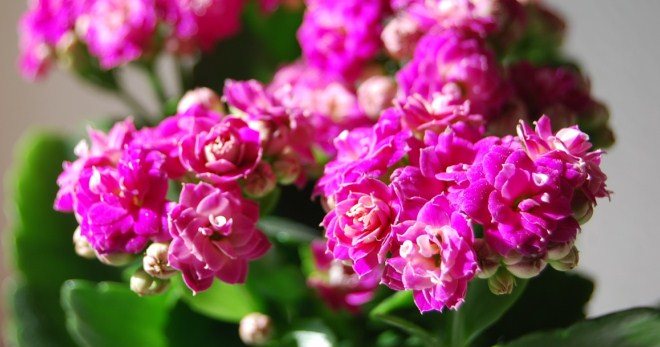

If the Kalanchoe does not bloom, whatever its owner would try to do, new ovaries will not appear without proper care and prevention of the appearance of diseases. A succulent plant may experience a stressful situation, or vice versa, need it so that the stem throws out the buds and the flowering process takes place without any defects.
Houseplant Kalanchoe Blossfeld. Caring for Blossfeld's Kalanchoe at home
In indoor conditions, Blossfeld's Kalanchoe grows rather slowly. It does not require special efforts and costs in care, due to which it has become widespread in indoor floriculture.
Lighting
Despite the fact that most species of Kalanchoe are light-loving plants, Blossfeld's Kalanchoe is an exception and tolerates partial shade well. But this may cause problems with flowering. To obtain abundant and long flowering, it is better to keep the plant on a well-lit windowsill facing the west or east side. In this case, the duration of daylight hours should be about 12 hours. In winter, you can move the flower to the southern windowsill.
Air temperature
Air temperature from +18 to + 25 ° С is comfortable for the plant. Blossfeld's Kalanchoe is sensitive to cold. At low temperatures, the flower hibernates, the formation of buds stops. The critical temperature is + 10 ° C. When staying for a long time in a room with such a temperature, the plant can get sick, even die. Therefore, in winter it is necessary to monitor the temperature regime. Wintering in a cool and damp room, as well as cold drafts, is especially dangerous for a plant.
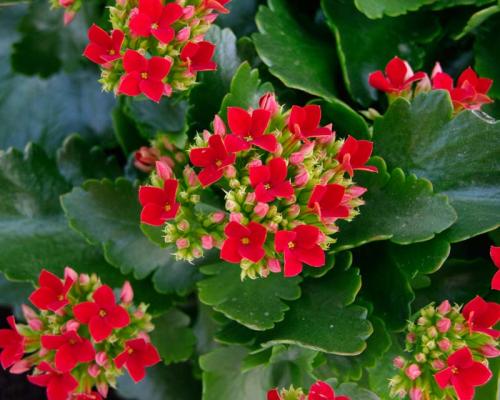

Humidity
Kalanchoe Blossfeld, like other Kalanchoe species, tolerates dry air well and does not require spraying. You can periodically wipe the leaves with a damp cloth for hygienic purposes.
Watering
As a succulent plant, Blossfeld's Kalanchoe thrives even in dry soil. Excessive moisture can lead to decay of roots and stems. Watering should be carried out only when the soil in the pot dries out: in the summer it is enough for the top 1/3 of the soil to dry out, in the winter - 2/3 or even completely earthen lump.
Transfer
It is not necessary to replant the plant immediately after purchasing it from the store. Better to postpone it until next spring. An adult plant needs to be transplanted every two to three years, after the end of flowering. Transplanted into any ready-made soil for succulents. When transplanting, it is necessary to make good drainage of the soil (expanded clay, broken brick will do).
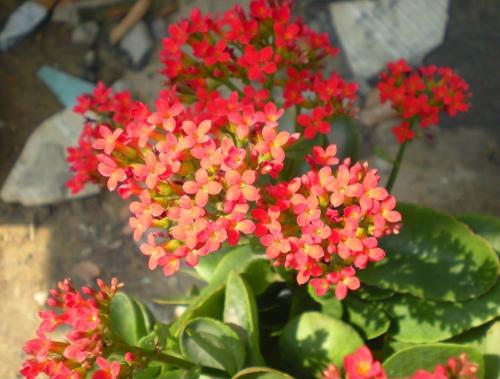

Top dressing
It is recommended to feed the plant during the flowering period - from the beginning of winter to the beginning of summer. Top dressing is carried out weekly in minimal dosages, using ready-made fertilizers for succulents. When forming buds, it is better not to use fertilizers, since the nitrogen contained in them can cause increased foliage growth to the detriment of flowering.
Post-flowering care
After each flowering, the plant needs proper pruning. When the flowers turn brown, the peduncle should be cut as low as possible. Other damaged shoots and leaves are also removed. New shoots are pinched after the appearance of the third pair of leaves, which allows you to form a lush compact bush, ready to bloom.
Learn more about how to care for the Blossfeld Kalanchoe at home.
The flowering Kalanchoe bush is a sign of proper plant care throughout the growing season. Observing the basic principles of maintenance, you can get a lush flowering at the desired time.
Separation of root suckers
After the end of flowering, the tip of the shoot is pinched in order to stimulate the development of offspring. As a result, young offspring appear near the mother flower. They are also used for reproduction. After that, the offspring can be separated and planted in a pot with a sandy sod substrate (8 parts of river sand, 2 parts of sifted sod land).
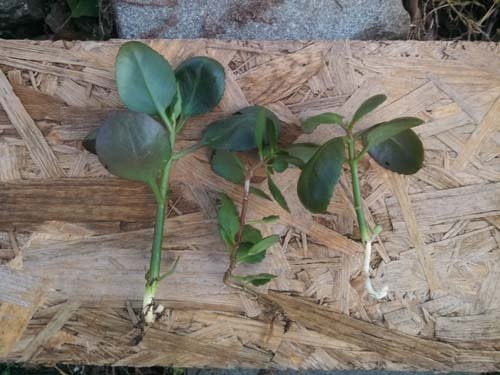

The offspring should reach 1/3 of the length of an adult plant.
Subtleties of care before rooting
Until the planted cuttings or leaves acquire their own root system, comfortable conditions must be maintained:
- provide young plants with plenty of light, but protect them from burns;
- keep them warm - at an ambient temperature of about 23-25º C;
- do not allow the soil to become waterlogged and completely dry out;
- protect the Kalanchoe cuttings from drafts, temperature stresses;
- for irrigation, use settled water, warmed up to ambient temperature;
- it is better to moisten the soil from a household sprayer, so as not to disturb the young plant once again.
An important point: it is better to underfill Kalanchoe water than pour it over. Therefore, start watering only after checking the moisture content of the planting mixture.
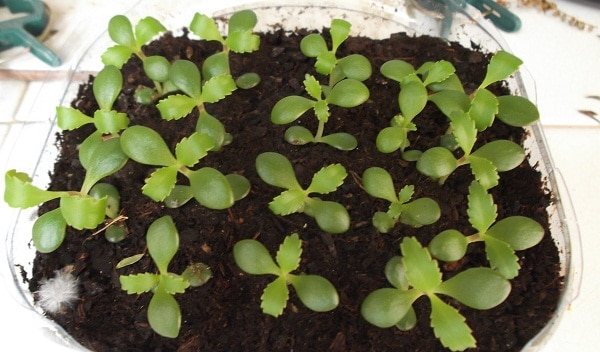

The main characteristics of a plant of the genus succulents
The roots of the Kalanchoe are thickened and fibrous. The stem of the plant is fleshy, sometimes lignified, covered with succulent thick leaves arranged in a spiral-opposite manner. The type of leaf plates depends on the variety and happens:
- Edged.
- Feathery.
- Simple.
- Have a scalloped edge.
In the same way, the size of the leaves can be different, so you can see a flower of this species with large, like a burdock, or, conversely, with small leaves. Peduncles are located either at the top or on the stems next to it. Flowers have four petals, which can be bright red, pink, white, orange or purple in color.
Necessary conditions for growing
Kalanchoe varieties Blossfeld, as a rule, are not considered whimsical for growing and breeding indoors. Nevertheless, if you do not take too seriously the process of ensuring the optimal microclimate for a plant, it will be quite difficult to wait for it to bloom violently. Of great importance for the development of this flower is the fact where it will be located, how intensely it will be illuminated, and at what temperature regime you are going to grow it. Consider all these points, and the Kalanchoe will delight you with its flowering.


Growing Kalanchoe will really give the desired result if you adhere to the following recommendations:
- moderate lighting. It is advisable to place this indoor flower on a well-lit windowsill. Nevertheless, shade it in the afternoon, otherwise you risk soon to notice burns on the leaves. Despite the fact that the Kalanchoe is a tropical plant, it certainly does not need too much light;
- temperature regime. This flower withstands coolness without any particular difficulties. But if the temperature reaches +25 ° C and higher, the plant may even die;
- humidity. Despite the fact that you are buying a tropical plant for your home, you should not go too far with the level of humidity. The thing is that it accumulates mostly in the stem of the flower, and not in its root system. All this can cause the flower to rot.
Study the description of the conditions vital for the successful cultivation of Kalanchoe at home, and get a flower that will delight you with its lush inflorescences.
Where did this flower come from on our windowsills
At the beginning of the 20th century, this flower was not even heard of - it was discovered only in 1932, less than a hundred years ago. As you might have guessed, the discoverer's surname was Blossfeld. He saw this shrub while traveling in Madagascar and could not resist - he immediately brought a sweet stranger to Europe.
The plant turned out to be harmful and did not take root well in our conditions. But Danish and Dutch breeders got involved. Their brainchild was able to boast of more noticeable leaves - large and bright, and the shades of flowers were added.
In addition to reds, European florists have at their disposal yellow, orange, pink and white flowers. But they all had only 4 petals.
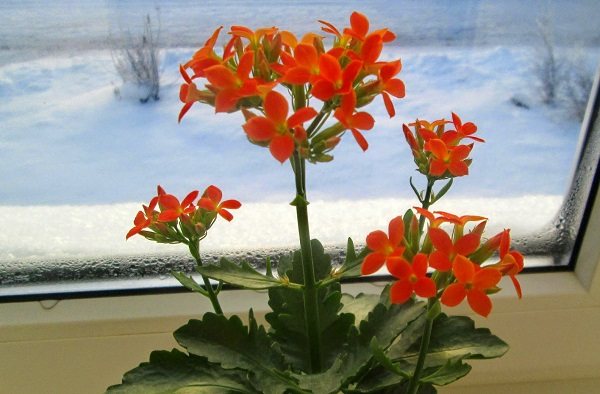

And just yesterday, at the beginning of the 21st century, the Swedes bred a new variety of this plant. Its flowers are decorated with many petals and look like miniature roses. The variety was named Kalanchoe Kalandiva. Most modern stores under the Blossfelda name sell this particular variety.
Read also: Adams' rhododendron: application, home care, beneficial properties
By the way, do not be surprised if you see "roses" not only of the above-mentioned shades, but also of green, or even several shades at once.
This beauty blooms for about one and a half months (while four-petal varieties - only 1.5 months). The pot is really unpretentious. Just a dream, not a flower!


Discovery history
Blossfeld's Kalanchoe was first discovered on the island of Madagascar. The plant variety was named after the German breeder Robert Blossfeld, who brought it to Potsdam in 1932. However, the first tropical specimens did not have such a large number of colors and included a poor palette of shades. Moreover, initially Kalanchoe did not gain wide popularity among flower growers: its weak adaptability to the conditions of houses and apartments affected. Nevertheless, over the years, the improved qualities of the variety were fixed, and the Kalanchoe was finally truly recognized by European growers.
Kalanchoe from seeds
Instructions for propagating Kalanchoe seeds:
- Prepared seeds of Kalanchoe Blossfeld are sown in open containers filled with well-steamed substrate in order to avoid infection and seed rot.
- On the leveled surface of the substrate, shallow grooves are pressed into which seeds are laid out at a distance of 3-4 cm from each other.
- The seeds should be lightly pressed into the pre-moistened soil.
- After a while, shoots appear.
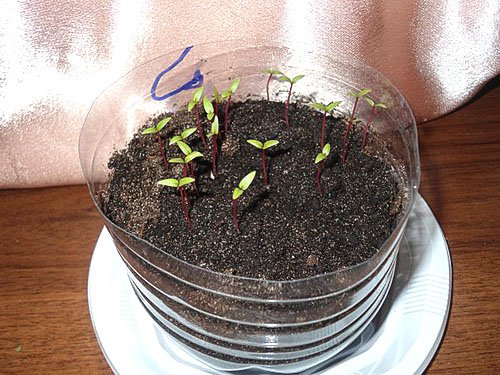

The temperature in the room where Kalanchoe seeds are germinated should not fall below 20 ° С
Dividing the bush
Dividing the mother plant is the easiest way to reproduce the Kalanchoe. Many species of succulents grow daughter plants that are quite suitable for transplanting them into a separate container. The whole process consists in removing an adult plant from a pot, cutting off suitable parts of a bush with roots with a knife and transplanting them into a separate container with fresh soil.


An adult plant constantly needs seating.
Reproduction of Kalanchoe by brood buds (children)
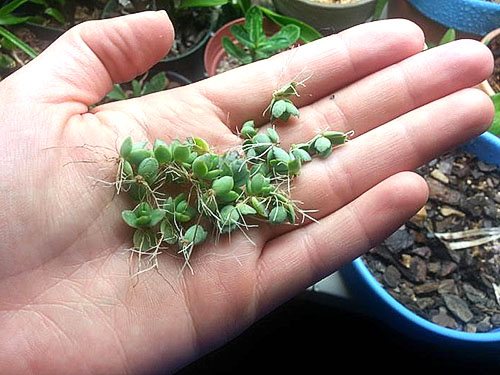

Answering the question of how the Kalanchoe reproduces by brood leaf buds (children), it should be noted that not all species of this succulent have them. Small daughter plants are formed on the leaves of the "viviparous" Kalanchoe. Other varieties of this flower do not form them. Kalanchoe babies have several leaves and roots. Adult succulents often shed their brood buds on their own, which take root at the base of the mother plant. They can be planted in separate pots with a fertile substrate. Fully formed offspring are gently broken off from an adult leaf and buried a little into the prepared substrate.

